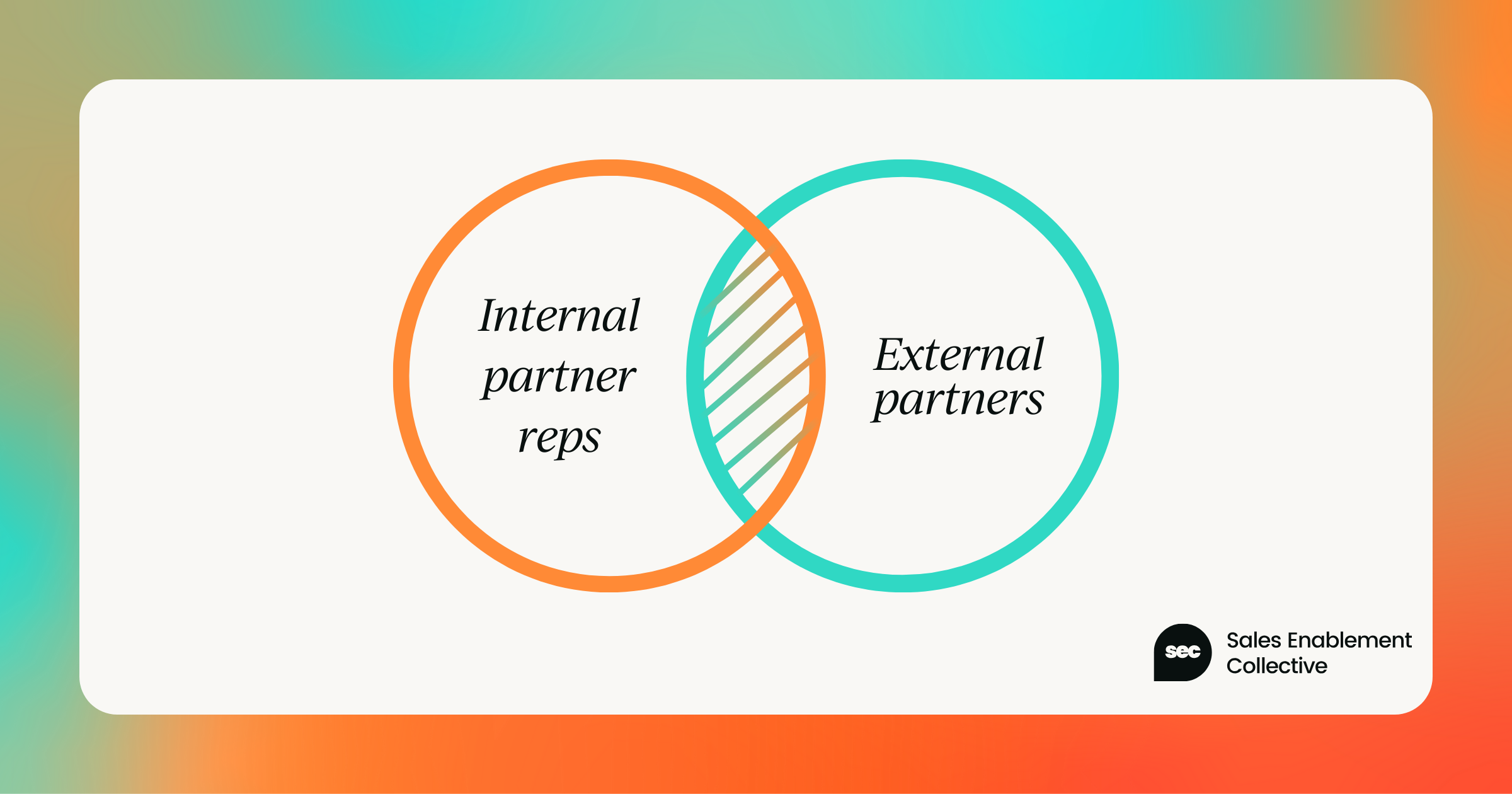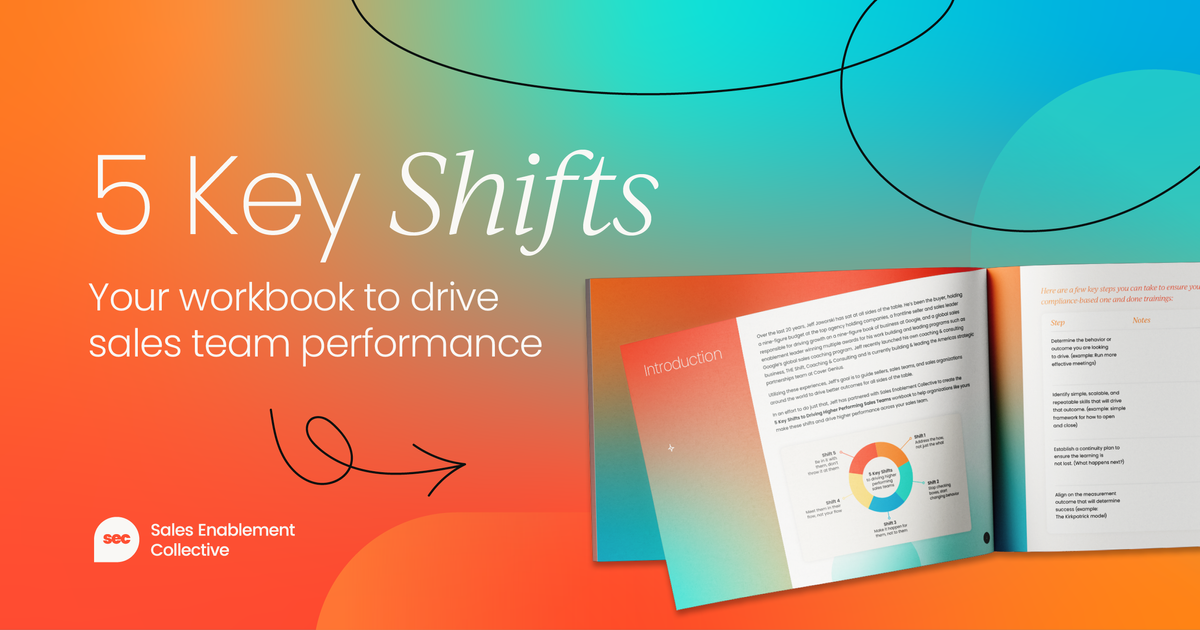When sales enablement took off, its offshoots followed.
Like tiny mind-children taking their first steps, revenue enablement, GTM enablement, and partner enablement stepped out into the sunlight.
Blinking up at the world, lesser enablement approaches would have crumbled. But these have stood the test of time.

Enabling your organization’s external partners just works. As a strategy, there are a bunch of extraordinary benefits. (We’ll get to these in just a second.)
But… partner enablement also poses a unique set of challenges. Challenges most enablement professionals aren’t used to.
What is partner enablement?
Partner enablement has two core components: external partner enablement, and the enablement of internal partner reps.
First, external partner enablement involves enabling the companies that resell your products (or services).
These partners have their own customers. They sell on your behalf, making them an extension of your company. We need to enable their teams to sell and talk about our products as effectively as our internal sales teams.
Second, there are your internal partner reps. That’s your partner sales managers, and partner development managers. They maintain relationships with your external partners.

For partner enablement to be effective, we need to equip both external partners and internal teams with the tools and knowledge to succeed.
Partner enablement is about making sure the boots-on-the-ground at partner companies are just as informed and capable as our internal sales teams. They need to speak about your products and services with the same confidence and knowledge as you do.
At the same time, you have to make sure your internal teams who support these partners are just as prepared.
Want your partner program to succeed? This dual focus is crucial.
Why is partner enablement important?
Not every business needs a partner enablement strategy.
But done right, there are some crazy benefits to partner enablement.
The benefits of partner enablement
- Higher customer satisfaction
Strong partnerships are “1+1=3” approaches to doing business. Together, your offerings become greater than the sum of their parts. Your partner might share their excellent customer success playbook with you. In turn, you share your development team’s SOPs with them. Both of you get better, more complete offerings, and higher customer satisfaction as a result.
- Higher retention
Strong partner enablement strategies involve partners in multiple ways. One of these involves integrating your solutions. The more partnerships you have, the stronger you can tie your integrations together, creating a SaaS ecosystem that competitors on the outside have a very hard time competing with. The result? Far lower customer churn.
- Break into new markets
Your partners will have different (but related) target audiences. A strong partnership gives you the means to access these audiences in ways that’d be impossible without their help.
- Cost-effective scaling
Get access to whole teams of new sales reps when you partner with others. Share resources for mutual gain.
- Improved relationships with stakeholders
Successful enablement leads to trust, and a cycle of continuous improvement and collaboration with stakeholders. This is a long-term benefit of effective partner enablement.

The similarities between partner enablement and sales enablement
Sure, sales enablers enable sales reps, while partner enablement involves enabling your channel partners.
But in practice?
Partner enablement and sales enablement aren’t that different.
1 - Both need custom content
Both partner and sales enablement need customized enablement content. You’ll use this to fit specific roles and use cases.
In sales enablement, we train sales teams on how to have different discussions depending on the use case or industry. In partner enablement, your partners need to understand your product’s use cases well, too.
2 - The 80/20 rule applies to both
The 80/20 rule applies to both types of enablement.
About 80% of your messaging, positioning, and value proposition will be the same, regardless of the deal type. But you’ll tailor a crucial 20% to different types of customer.
In partner enablement, you’ll tailor 20% to the partner type or vertical.
Customizing content makes your enablement efforts resonate with your audience. Be they internal reps, or external partners.
3 - Both require content efficiency
Enablement teams are small. They’re often strapped for resources.
If you operate inefficiently, you’ll miss out on the impact you could have otherwise achieved.
This is true whether you’re practicing sales enablement or partner enablement.
As Brooke Coletti, Sr. Enablement Manager at AWS puts it:
“Another similarity is the importance of sharing enablement content across teams. Whether a need arises from a partner or is identified internally, it’s crucial for the enablement team to communicate and share content to scale effectively. This collaborative approach helps ensure consistency and efficiency in your enablement efforts.”
Key differences between partner enablement and sales enablement
While there are similarities, there are also some notable differences between partner enablement and sales enablement.
1 - Partners need finalized messaging from the start
One significant difference is that your partners need proven messaging.
When we’re enabling sales, we can afford to try out new things. Not so with your partners.
Partners often sell your competitors' products, as well as yours. If your value propositions aren't compelling and easy to understand, those partners might find it easier to sell your competitors' products instead.
Make it the path of least resistance for them to sell your stuff. Give them proven messaging from the start.
2 - Partners need “just enough” information
You engage with your internal teams frequently, but you won’t touch base with your partners as often. They have other responsibilities, and might not have the bandwidth to process frequent updates.
Therefore, your enablement materials need to be:
- Concise,
- Relevant,
- Easy to digest.
3 - Getting feedback from partners is more challenging
Sales reps are loud.
If they’re missing vital content, they’ll tell you. The same is true for content that’s not up to scratch.
Getting feedback from partners, however? This can be more challenging.
To get this right, you’ll have to build strong relationships. Only then will your partners offer you the candid feedback you need to improve. Without it, there’ll be an artificial ceiling on the value you can get out of your partner program.
How to set up and enable channel partnerships (a step-by-step guide)
In business, there are certain processes you’ll repeat time-and-again. Getting these processes down to a fine art pays off. Big time.
The processes include:
- Hiring
- Onboarding
- Re-investing
These processes actually apply to all of these business relationships:
- Customers (advertise for new customers, hold sales calls with them, onboard them, train them on your platform, then check-in with them to ensure they’re getting value and staying involved.)
- Staff (advertise for new job roles, negotiate with applicants, onboard them, train them, check-in with them to ensure they’re moving in the right direction and staying engaged.)
- Partners (advertise for new partners, negotiate terms, onboard them, train them, check-in with them about their experience.)
Yep, all these processes apply to working with partners too.
Let’s look at the process as it applies to partners in some more detail:
1 - “Hiring”
Assess the current state of partnerships
In the initial stage, you need to find worthy potential partners. Then, you need to bring them on board by negotiating the terms of your partnership.
Before you can do this, you need to know what worthy looks like.
What are you looking to get out of this? Where are the bigger bottlenecks in your business, and how might getting partners involved solve them?
Make sure you:
- Understand your organization’s goals, vision, and roadmap
- Use data to sense-check your point-of-view, and make sure it’s objective
Engage partners
This is where you’ll do your initial outreach, float the idea of a deal, and start to establish your relationship.
It’s beyond the scope of this article, but at this stage, it’s worth doing some research into what successful partnerships look like, and what style might suit you.
Once you know what you’re looking for, all that’s left to do is find candidates who fit your “ideal partner profile”, reach out to them, and begin a conversation.
Use incentives to help you land the deal. Frame the partnership as a win/win, help them see what’s in it for them, and you’ll be off to a strong start.
2 - Onboarding
Just as you onboard and train new members of internal staff, you need to do the same for your partner reps.
Effective, time-efficient training is the name of the game here. The aim is to use the processes you already have in place to get partner reps up-to-speed with as short a ramp-time as possible.
Introduce partner reps to:
- Your systems,
- Your processes,
- Your modes of communication.
This is also a great time to set goals with your partners. Now that they’re on board, the goals you set during early conversations will serve to motivate both sides during the crucial first 30-60-90 day periods of your partnership.
3 - Re-investing
Steps:
- Create resources and training materials
- Marketing and sales assets/content
- CRM and other tools in the tech stack
- Set up comms channels
- Assess ongoing performance using KPIs and qualitative feedback
- Iterate and improve
Onboarding isn’t the end. Just as you continue to re-invest in your own staff and customers with training and coaching, or new feature releases, so must you continue to re-invest in your partnerships.
When it comes to training, train partner reps on the sales techniques that work best for you. Train them to use new messaging you’re rolling out. Even train them to use your enablement materials.
The better you train your partner reps, the better they’ll perform when selling your products.
And it doesn’t stop at training.
Partner enablers should continually create enablement collateral that meets partners’ developing needs. To understand these needs, you’ll need to check-in with your partner for feedback. Hold regular conversations with them about how things are going, what’s going well, and what needs adjusting.
Investing in your partnership shows your continued commitment to making your relationship work. This is necessary if you’re to keep your partner teams motivated, and aware of the benefits they’re getting, so they keep working hard to benefit you in turn.
Common challenges in partner enablement
1 - Gaining feedback from partners
While internal teams are vocal about their needs, you have to work to get that kind of feedback from external partners.
But for those that persevere, a treasure-trove awaits.
Partners have access to intel you don’t. They can tell you what resonates with different industries and company sizes.
This kind of intel is valuable, and makes this an important challenge to overcome.

2 - Optimizing your messaging
Another challenge is balancing broad, high-level messaging with specific, actionable content.
“We need to provide partners with a 30,000-foot view that applies to the masses while also making sure we’re diving into specific details.” - Brooke Coletti, Sr. Enablement Manager, AWS
This balance is essential for effective partner enablement.
How to solve these challenges
While enablement typically doesn’t have an influence on how partners get paid, you can still make an effort to understand how they’re compensated.
Some partnerships follow a tiered approach to compensation. For example, you might have bronze, silver, or gold level partners.
What are the requirements for each level? Is there a training requirement for each one? Do they need to do a minimum amount of business to maintain their level, or advance to another?
This kind of knowledge can help you deliver critical, but appropriate messaging and value propositions to your partners.
From there, you can build survey mechanisms or “voice of the partner” initiatives to get feedback.
Other challenges in partner enablement
- Indirect results – 37% of respondents in our 2024 Sales Enablement Landscape Report said they were not on the same page as their leadership teams when it comes to what metrics enablement should be assessed on. This disconnect in understanding where and how enablement can offer value is often amplified in partner enablement, where there are more degrees of separation between actions and results.

- Amplified challenges for teams lacking strong internal relationships – For your external relationships to flourish, your internal relationships must first be rock-solid. Unfortunately, in the Sales Enablement Landscape Report 2024, over a quarter (26%) of respondents said they wish they had a better relationship with their internal sales team and sales management. Teams without strong internal relationships may struggle to communicate to external partners with enough clarity to succeed.

How to enable internal partner reps
Training internal partner reps, or “training the trainers,” is a fundamental aspect of partner enablement.
There’s a fundamental difference between enabling direct sales reps, who are selling directly to the customer, and then enabling these partner reps, who are the ones training your partner to sell your products.
Partner reps need to be well-versed in your products and resources to support partners effectively. They’ll often act as the face of your company, representing you in interactions with your partners.
Enable them like this...
If your partner reps don’t feel well-resourced and confident, it’s not just them who’ll suffer. Your partners will suffer too.
These reps should be able to:
- Support your partners through the sales process,
- Anticipate and provide necessary collateral,
- Join calls with partners and customers.
To enable your partner reps, every piece of enablement material has to be easily accessible.
In the 5 Key Shifts Workbook, Jeff Jaworski, Senior Vice President of Strategic Partnerships, Americas at CoverGenius, emphasizes the transformative effect of meeting sellers “in their flow, not your flow”.
Use tags and filters in your enablement software to allow reps to quickly find and share relevant information during calls.
Tips for transitioning into partner enablement
1 - Understand the business case
Find yourself doing partner enablement, but aren’t sure how to succeed?
Start by gaining an understanding of the business case for the shift. Why is the company focusing on partner enablement now more than before?
Building a partner ecosystem can take time. It’s important you (and your stakeholders) understand that going in.
You have to nurture relationships. Build them from the ground up. It might take 18–24 months to see results.
If you’re a team covering both partner and internal enablement, start by building internal content. Once that’s built, you can adapt it for external use. Don’t forget to check your messaging is polished to minimize confusion.
For larger teams dividing up partner and internal enablement responsibilities, make sure there’s alignment. Share content and collaborate. Always view your internal and external partner organizations as extensions of the sales team.
2 - Treat partners like VIP customers
The parallel between partners and customers is strong. Your best partners will bring a lot of value into your business. It’s important to nurture those relationships and show your partners how much you value them.
Run special events for your partners, and make sure to create a strong end-to-end user experience for them.
Wrap-up
Smaller companies and enablement functions may struggle with the scope of work required to spin up profitable partnerships successfully (and keep them running).
But given the prevalence of enterprise-level partnership strategies, enablement professionals of all shapes and sizes may one day find themselves enabling partners and partner reps, rather than internal sales reps.
Brooke Coletti’s advice is this:
“If you get an opportunity to do a partner enablement role, I definitely encourage you to try it out because it’s very eye-opening.
“Partner enablement offers unique challenges and opportunities, and experiencing it can significantly enrich your career in enablement.”
Looking for next steps?
10,000+ sales enablers from all over the world trust SEC to be the go-to resource for their learning and development. Benefit from our community-led resources through the insider plan, for free!
- Templates and frameworks: Save time with battle-tested and ready-to-use templates. 📖
- SEC-GPT: Solve challenges with the cumulative knowledge of our community. 🤖
- Real-world case studies: Hours of insights from leaders at Uber, Oracle, Adobe, and more. 🗣️
- Industry insights: Ungated access to first-hand research from thousands of sales enablers in our annual Salary and Landscape Report. 📈
- Supportive community: Join our global community of sales enablers whom you can bounce ideas around with and get support from other like-minded professionals. 🤝
Accelerate your career without spending a dime.
Become an SEC insider now. 👇



Sales enablement insider
Thank you for subscribing
Level up your sales enablement career & network with sales enablement experts
An email has been successfully sent to confirm your subscription.
 Follow us on LinkedIn
Follow us on LinkedIn


.png)








